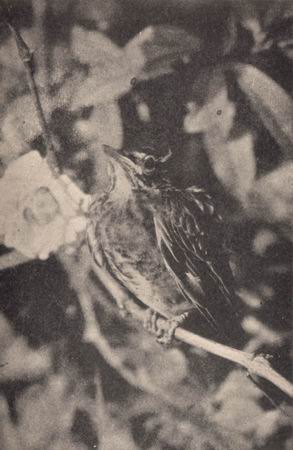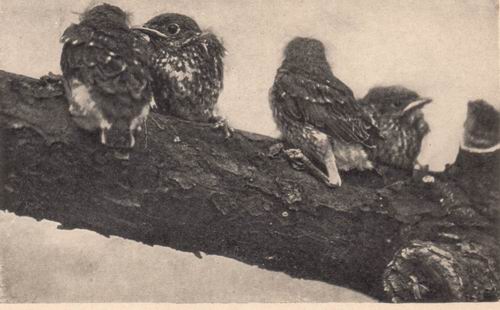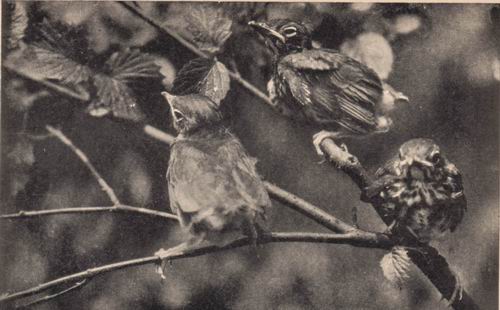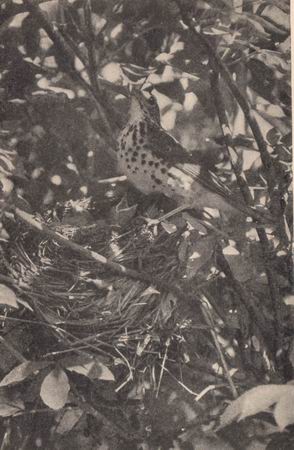|
(Return to Web Text-ures) |
Click Here to return to Birds Every Child Should Know Content Page |
 (HOME) |
|
(Return to Web Text-ures) |
Click Here to return to Birds Every Child Should Know Content Page |
 (HOME) |
|
CHAPTER I
OUR ROBIN GOODFELLOW AND HIS RELATIONS: AMERICAN ROBIN BLUEBIRD WOOD THRUSH WILSON'S THRUSH THE AMERICAN ROBIN Called also: Red-breasted Thrush; Migratory Thrush; Robin Redbreast IT IS only when he is a baby that you could guess our robin is really a thrush, for then the dark speckles on his plump little yellowish-white breast are prominent thrush-like markings, which gradually fade, however, as he grows old enough to put an a brick-red vest like his father's. The European Cock Robin -- a bird as familiar to you as our own, no doubt, because it was he who was killed by the Sparrow with the bow; and arrow, you well remember, and it was he who covered the poor Babes in the Wood with leaves -- is much smaller than our robin, even smaller than a sparrow, and he is not a thrush at all. But this hero of the story books has a red breast, and the English colonists, who settled this country, named our big, cheerful, lusty bird neighbour a robin, simply because his red breast reminded them of the wee little bird at home that they had loved when they were children. When our American robin comes out of the turquoise blue egg that his devoted mother has warmed into life, he usually finds three or four baby brothers and sisters huddled within the grassy cradle. In April, both parents worked hard to prepare this home for them. Having brought coarse grasses, roots, and a few leaves or weed stalks for the foundation, and pellets of mud in their bills for the inner walls (which they cleverly managed to smooth into a bowl shape without a mason's trowel), and fine grasses for the lining of the nest, they saddled it on to the limb of an old apple tree. Robins prefer low-branching orchard or shade trees near our homes to the tall, straight shafts of the forest. Some have the courage to build among the vines or under the shelter of our piazzas. I know a pair of robins that reared a brood in a little clipped bay tree in a tub next to a front door, where people passed in and out continually. Doubtless very many birds would be glad of the shelter of our comfortable homes for theirs if they could only trust us. Is it not a shame that they cannot? Robins, especially, need a roof over their heads. When they foolishly saddle their nest on to an exposed limb of a tree, the first heavy rain is likely to soften the mud walls, and wash apart the heavy, bulky structure, when “Down tumble babies and cradle and all." It is wiser of them to fit the nest into the supporting crotch of a tree, as many do, and wisest to choose the top of a piazza pillar, where boys and girls and cats cannot climb to molest them, nor storms dissolve their mud-walled nursery. There are far too many tragedies of the nests after every heavy spring rain. Suppose your appetite were so large that you were compelled to eat more than your weight of food every day, and suppose you had three or four brothers and sisters, just your own size, and just as ravenously hungry. These are the conditions in every normal robin family, so you can easily imagine how hard the father and mother birds must work to keep their fledglings' crops filled. No wonder robins like to live near our homes where the enriched land contains many fat grubs, and the smooth lawns, that they run across so lightly, make hunting for earth worms comparatively easy. It is estimated that about fourteen feet of worms (if placed end to end) are drawn out of the ground daily by a pair of robins with a nestful of babies to feed. When one of the parents alights near its home, every child must have seen the little heads, with wide-stretched, yellow bills, pop up suddenly like Jacks-in-the-box. How rudely the greedy babies push and jostle one another to get the most dinner, and how noisily they clamour for it! Earth worms are the staff of life to them just as bread is to children, but robins destroy vast quantities of other worms and insects more injurious to the farmers' crops, so that the strawberries and cherries they take in June should not be grudged them. A man of science, who devoted many hours of study to learn the great variety of sounds made by common barnyard chickens in expressing their entire range of feeling, from the egg shell to the axe, could entertain an audience delightfully for an evening by imitating them. Similar study applied to robins would reveal as surprisingly rich results, but probably less funny. No bird that we have has so varied a repertoire as Robin Goodfellow, and I do not believe that any boy or girl alive could recognise him by every one of his calls and songs. His softly warbled salute to the sunrise differs from his lovely even-song just as widely as the rapturous melody of his courting days differs from the more subdued, tranquil love song to his brooding mate. Indignation, suspicion, fright, interrogation, peace of mind, hate, caution to take flight-these and a host of other thoughts, are expressed through his flexible voice. 
It is only when he is a baby that you could guess our robin is really a thrush

The Bluebird Toward the end of June, you may see robins flying in flocks after sun-down. Old males and young birds of the first brood scatter themselves over the country by day to pick up the best living they can, but at night they collect in large numbers at some favourite roosting place. Oftentimes the weary mother birds are now raising second broods. We like to believe that the fathers return from the roosts at sun-up to help supply those insatiable babies with worms throughout the long day. After family cares are over for the year, robins moult, and then they hide, mope, and keep silent for awhile. But in September, in a suit of new feathers, they are feeling vigorous and cheerful again; and, gathering in friendly flocks, they roam about the woodland borders to feed on the dogwood, choke cherries, juniper berries, and other small fruits. You see they change their diet with the season. By dropping the undigested berry seeds far and wide, they plant great numbers of trees and shrubs as they travel. Birds help to make the earth beautiful. With them every day is Arbour Day. It is a very dreary time when the last robin leaves us, and an exceptionally cold winter when a few stragglers from the south-bound flocks do not remain in some sheltered, sunny, woodland hollow.
THE BLUEBIRD
Is there any sign of spring quite so welcome as the glint of the first bluebird unless it is his softly whistled song? Before the farmer begins to plough the wet earth, often while the snow is still on the ground, this hardy little minstrel is making himself very much at home in our orchards and gardens while waiting for a mate to arrive from the South. Now is the time to have ready on top of the grape arbour, or under the eaves of the barn, or nailed up in the apple tree, or set up on poles, the little one-roomed houses that bluebirds are only too happy to occupy. More enjoyable neighbours it would be hard to find. Sparrows will fight for the boxes, it is true, but if there are plenty to let, and the sparrows are persistently driven off, the bluebirds, which area little larger though far less bold, quickly take possession. Birds that come earliest in the season and feed on insects, before they have time to multiply, are of far greater value in the field, orchard, and garden than birds that delay their return until warm weather has brought forth countless swarms of insects far beyond the control of either bird or man. Many birds would be of even greater service than they are if they received just a little encouragement to make their homes nearer ours. They could save many more millions of dollars' worth of crops for the farmers than they do if they were properly protected while rearing their ever-hungry families. As two or even three broods of bluebirds may be raised in a box each spring, and as insects are their most approved baby food, you see how much it is to our interest to set up nurseries for them near our homes. But when people are not thoughtful enough to provide them before the first of March, the bluebirds hunt for a cavity in a fence rail, or a hole in some old tree, preferably in the orchard, shortly after their arrival, and proceed to line it with grass. From three to six pale blue eggs are laid. At first the babies are blind, helpless, and almost naked. Then they grow a suit of dark feathers with speckled, thrush-like vests similar to their cousin's, the baby robin's; and it is not until they are able to fly that the lovely deep blue shade gradually appears on their grayish upper parts. Then their throat, breast, and sides turn rusty red. While creatures are helpless, a prey for any enemy to pounce upon, Nature does not dress them conspicuously, you may be sure. Adult birds, that are able to look out for themselves, may be very gaily dressed, but their children must wear sombre clothes until they grow strong and wise. Young bluebirds are far less wild and noisy than robins, but their very sharp little claws discourage handling. These pointed hooks on the ends of their toes help them to climb out of the tree hollow, that is their natural home, into the big world that their presence makes so cheerful. As you might expect of creatures so heavenly in colour, the disposition of bluebirds is particularly angelic. Gentleness and amiability are expressed in their soft, musical voice. Tru-ally, tru-al-ly, they sweetly assert when we can scarcely believe that spring is here; and tur-wee, tur-wee they softly call in autumn when they go roaming through the country side in flocks of azure, or whirl through Southern woods to feed on the waxy berries of the mistletoe.
THE WOOD THRUSH
Called also: Song Thrush; Wood Robin; Bell Bird
Much more shy and reserved than the social, democratic robin is his cousin the wood thrush, whom, perhaps, you more frequently hear than see. Not that he is a recluse, like the hermit thrush, who hides his nest and lifts up his heavenly voice in deep, cool, forest solitudes; nor is he even so shy as Wilson's thrush, who prefers to live in low, wet, densely overgrown Northern woods. The wood thrush, as his name implies, certainly likes the woodland, but very often he chooses to stay close to our country and suburban homes or within city parks with a more than half-hearted determination to be friendly.  The Wood Thrush  A wood thrush startled by the click of the camera He is about two inches shorter than the robin. Above, his feathers are a rich cinnamon brown, brightest on his head and shoulders and shading into olive brown on his tail. His white throat and breast and sides are heavily marked with heart-shaped marks of very dark brown. He has a white eye ring. "Here am I" come his three clear, bell-like notes of self-introduction. The quality of his music is delicious, rich, penetrative, pure and vibrating like notes struck upon a harp. If you don't already know this most neighbourly of the thrushes -- as he is also the largest and brightest and most heavily spotted of them all you will presently become acquainted with one of the finest songsters in America. Wait until evening when he sings at his best. Nolee-a-e-olee-nolee-aeolee-lee! peals his song from the trees. Love alone inspires his finest strains; but even in July, when bird music is quite inferior to that of May and June, he is still in good voice. A song so exquisite proves that the thrush comes near to being a bird angel, very high in the scale of development, and far, far beyond such low creatures as ducks and chickens. Pit-pit-pit you may hear sharply, excitedly jerked out of some bird's throat, and you wonder if a note so disagreeable can really come from the wonderful songster on the branch above your head. By sharply striking two small stones together you can closely imitate this alarm call. Whom can he be scolding so severely? It is yourself, of course, for without knowing it you have come nearer to his low nest in the beech tree than he thinks quite safe. While sitting, the mother bird is, however, quite tame. A photographer I know placed his camera within four feet of a nest, changed the plates, and clicked the shutter three times for as many pictures without disturbing the gentle sitter who merely winked her eye at each chick. Wood thrushes seem to delight in weaving bits of paper or rags into their deep cradles which otherwise resemble the robins.' A nest in the shrubbery near a bird-lover's home in New Jersey had many bits of newspaper attached to its outer walls, but the most conspicuous strip in front advertised in large letters "A House to be Let or Sold." The original builders happily took the next lease, and another lot of nervous, fidgety baby tenants came out of four light greenish-blue eggs; but, as usual, they moved away to the woods, after ten days, to join the choir invisible.
WILSON'S THRUSH The veery, as the Wilson's thrush is called in New England, is far more common there than the wood thrush, whose range is more southerly. During its spring and fall migrations only is it at all common about the elms and maples that men have planted. Take a good look at its tawny coat and lightly spotted. cream buff breast before it goes away to hide. Like Kipling's "cat that walked by himself," the veery prefers the "wild, wet woods," and there its ringing, weird, whistling monotone, that is so melodious without being a melody, seems to come from you can't guess where. The singer keeps hidden in the dense, dark undergrowth. It is as if two voices, an alto and a soprano, were singing at the same time: Whee-you, whee-you: -- the familiar notes might come from a scythe being sharpened on a whetstone, were the sound less musical than it is. The bird is too wise to sing very near its well-hidden nest, which is placed either directly on the damp ground or not far above it, and usually near water. Throughout its life the veery seems to show a distrust of us that, try as we may, few have ever overcome. If you have thought that the thrush-like, cinnamon brown, speckle-breasted bird, with a long twitching tail like a catbird's, and a song as fine as a catbird's best, would be mentioned among the robin's relations, you must guess again, for he is the brown thrasher, not a thrush at all. You will find him in the Group of Lively Singers. |